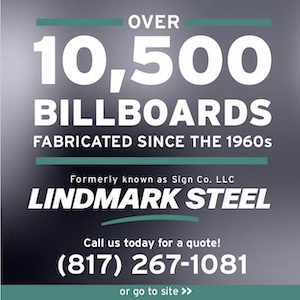 By Rocky Sisson Past L. Ray Vahue Award Winner
By Rocky Sisson Past L. Ray Vahue Award Winner
thought leadership from OAAA
One of the great presidential campaigns of all time was for President Bill Clinton’s first term. He had a sign hanging in the campaign’s “war room” that said It’s the economy, stupid! Regardless of the question, every answer linked back to the economy. In the minds of his staff, the economy was the source of all problems, and if the economy could be fixed, everything else would work. The opposition was immediately defensive when questioned about the economy. The campaign pounded this singular message.
As an account executive in out of home (OOH) advertising, “it’s the creative, stupid” should be your mantra. If you fight with creative, making it the bold statement of what you represent, competitors in other media will always come up short.
Making customers true believers in OOH requires they truly understand how the medium can engage customers and deliver an impactful message in just a few moments. While data and statistics are important, it’s only part of the equation. Customers will only really embrace OOH when they believe it can solve problems and grow business.
When having difficulty moving a customer into OOH, consider asking this simple question, “Putting aside all we discussed and assuming the creative messaging is correct, do you believe OOH can engage your customers in an efficient way?” To put it more simply, “Do you believe OOH can work for you?”
This has always been the hidden objection. In my experience, if an account executive cannot address this and force it onto the table, a customer will not be convinced OOH will work for them. By starting a conversation and asking questions to truly clarify the objection, an account executive can advance the opportunity. Remember, just because an objection is not raised does not mean it does not exist.
 These conversations can be so much fun. When you are talking about creative with a client, you are getting right down into the core of their business. There is no better lens than the creative lens to truly understand the core values of a business. That is what makes OOH magical. When the OOH creative is good, no other medium can beat it!
These conversations can be so much fun. When you are talking about creative with a client, you are getting right down into the core of their business. There is no better lens than the creative lens to truly understand the core values of a business. That is what makes OOH magical. When the OOH creative is good, no other medium can beat it!
Who the competition is and how they sell their products is an important part of the OOH strategy, too. Never lead with or focus on something a competitor can do better. I would always remember this when making a sales call. What is my customer going to say when my competitor questions his move to OOH and attempts to move him back? Am I set up to win that discussion when I’m not even in the room? So many times, the final decision is made when you are not present so you need to be clear on those key message points that will drive a permanent move to OOH and away from a competitor.
To be clear, a competitor means everybody who is against you. Other media, maybe someone else in that organization, anybody who could derail a deal.
Once a customer is emotionally committed, OOH’s advancements in data and measurement can help drive success to create a customer for life. The exponential growth in today’s data should help drive OOH share. OOH should be demanding a much greater share from buys. Data can show why.
When selling with data, understand the difference between selling boards and campaigns. Showing the individual impact of a single unit or the massive impact of a campaign are very different. Never make a decision in advance for a customer. Let them choose the objectives.
The objective for an OOH account executive should never be about selling a board, it’s about selling a campaign (which might be one board or a multimedia mix of OOH formats). Think in those terms.
One of the remarkable truths about being an OOH account executive is staying power. Once a customer moves to OOH and use it in the right way, they never leave.
Creative creates an emotional attachment to OOH. So, open every client meeting with a creative discussion. Get them thinking about presenting their business using the power of OOH. Leave no objection unresolved, even if you’re forced to drag it out of them.
Understand your competitors and how they sell and the benefits they recommend. Position yourself to win against those recommendations. Use data to drive share or to answer objections.
It’s that simple. But, not that easy.
[wpforms id=”9787″]
Paid Advertisement


















Very good article from Rocky. Back in our POA days, we learned that getting the prospect engaged in a conversation about the creative would get them emotionally involved and put the cost factor on the back burner. Still works today if you start the conversation with a question, “If I were to give you a free billboard/shelter/bench, what would you put on it?” It always helps to have some great creative designs or photos to show as the discussion develops.
Reminds me of a Wednesday morning training meeting in Orlando….many, many years ago. Wise words that transcend time in the OOH space.
Great article, Rocky! It sounds like you and Ray and I were paying attention to our sales guru and creative director back in the day at POA. Strong creative and an educational selling strategy help sell ad space and make renewals easier. This only gets truer as the market becomes more competitive. The “free ad” question is an excellent way to engage a prospective advertiser in a co-operative discussion about their selling message instead of the cost of the ad space.
Great article Rocky. Much appreciated. The first time someone said to me “creative sells” I had the deer in the headlights look on my face. But after he explained it, it made total sense…and I think it reverberates your article above.